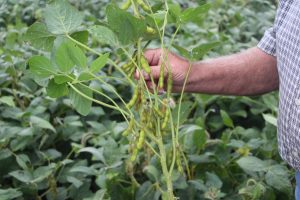Agronomy, Homepage Slider, Soybean Quality
Managing Nutrients for Maximum Soybean Yields
By Dusty Sonnenberg, CCA, Ohio Field Leader: a project of the Ohio Soybean Council and soybean checkoff.
Soybean farmers in both the United States and Canada, strive to constantly achieve higher yields. Horst Bohner has been the Soybean Specialist for the Ontario Ministry of Agriculture for 20 years. In that time, he has studies factors impacting soybean yield in a number of growing environments and field conditions.
“Yield potential is not held back as much by heat units and day length and water as I used to think,” said Bohner. “We used to say that yield was made in August, that if you got a lot of rain then you would get a big crop. But over the years, I have seen that if you have the right year, with the right additives, and the right management, we can get some incredible yields.”
Bohner has pondered the question, “What is the fundamental difference between a part of a field that yields 50 bushels per acre (bu/ac) and a part of a field that yields 100 bu/ac?” “We used to say it was the soil water holding capacity, and it’s crop stress that is removing our yield potential,” said Bohner. “It is also very much tied to the availability of nutrients in the plant at the right time. Missing key nutrients can hold you back. One example is potassium deficiency, which is a significant issue in parts of Ontario.”
Bohner has been conducting soybean nutrient response trials for the past 10 years. In the research, Bohner has built-up the soil test levels, to be in a maintenance to draw down range, for just phosphorus (P) or just potassium (K) or both P and K, to compare to lower soil test value soils. The crop rotation has been corn, soybeans and wheat. “If your soil test is on the lower end, and you apply the recommended fertilizer P and K, based on the soil test levels, we found a 5-bushel increase,” said Bohner. “When we compare that to a field where we have built the soil test levels, and apply additional P and K, we did not see a yield increase.”
“Soybeans will respond to fertilizer application of P and K if the soil test is on the lower side, but not yield as high as soybeans in fields with good soil test levels of P and K and not additional application,” said Bohner. “Soil health and healthy plant roots also play a role in the results.”
Farmers and researchers alike have asked the question if soybeans will respond to a Nitrogen (N) fertilizer application? “The amount of N it takes to raise an 80-bushel soybean crop is tremendous,” said Bohner. “When measuring the total N in the seed and stover for an 80-bushel soybean crop, it takes 387 pounds, compared to 270 pounds of N in a 200-bushel corn crop.”
While soybeans can fix their own nitrogen, it is not enough to maximize their genetic yield potential. “There is evidence that 300-350 pounds of N is all that is available in the soil and that the plant can fix. That is nowhere near the 500# of N needed for a 100-bushel soybean crop. That raises the question if we can boost yields with N fertilizer supplemented,” said Bohner. “Unfortunately, the trial results are not consistent.”
“Some 2020 data showed that soybean yield can be boosted if nutrients are an issue,” said Bohner. “If beans are planted early in the spring, and in a no-till environment, there could be stress, and an opportunity for a response to supplemental nutrients.”
In the 2020 trial, comparisons were made between Urea alone, or Ammonium Sulfate alone, or Aspire alone, or Aspire + MESZ + KMAG + AMS, or Aspire + MESZ + KMAG + AMS + Stratego Pro (at R1.5) + Acapela (at R3.5). “There was no significant increase with urea or ammonium sulfate, but adding Aspire or an aspire package with MESZ and KMAG and AMS added more yield.,” said Bohner. “I am convinced that if a farmer is going to apply additional nutrients to soybeans, increasing yield is about the entire nutrient package, not just one or two nutrients. The other factor is that the more inputs you add, economics can become a factor. There is still a lot to learn about feeding soybeans.”